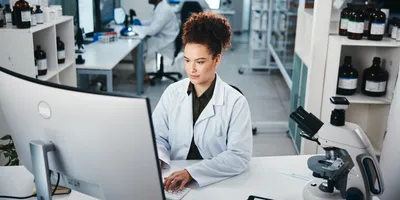While working in a biopharma lab, staff may be exposed to many different types of hazardous materials, based on the lab’s work and their job duties. These hazardous materials and situations may include:
- Biological hazards, such as human blood, cells, or tissues, biological toxins, synthetic peptides, recombinant DNA, etc.,
- Chemical hazards, such as chemical disinfectants, toxic chemicals, carcinogens, etc., and
- Physical hazards, such as high temperatures, wet surfaces, sharp objects, repetitive motions, etc.
Ensuring that the lab is prepared for an accident with or exposure to these hazards is critically important to ensure the health and safety of lab staff. By planning for these types of events in advance, you can equip your staff with the confidence to follow existing procedures and leverage relationships with medical responders.
How can you prepare your biopharma lab for accidents and exposures?
The first step in preparing for lab accidents and exposures is to assess what kinds of incidents could occur in your lab and what types of hazardous materials are used, even if they are not handled regularly. Consulting with your organization’s environmental and occupational health and safety group or available subject matter experts (SMEs) can help you create this list of potential lab emergencies and assist in creating procedures to respond to them.
Spill response
When preparing for potential spills in your biopharma lab, you should evaluate the regular and maximum volumes of the different types of hazardous materials that are used and transported to/from the lab as well as the typical type of containers that are used. Procedures should be drafted that address how to handle spills in the open lab space and within pieces of processing equipment (centrifuges, fridges, freezers, incubators, biosafety cabinets, chemical fume hoods, etc.) based upon the type(s) and volume(s) of materials that could be spilled. If biological materials or toxic chemicals are spilled, potentially infectious aerosols or hazardous vapors may be released that could necessitate evacuation of the lab. Consult with your health and safety SMEs for assistance in evaluating the risks of these spills and the appropriate response procedures.
It is advisable to have a spill kit assembled to make cleanup easier based on your lab’s spill procedures. This kit should be specific to your lab’s potential spill scenarios, but it should generally include absorbent materials, bags, or containers to collect the waste during cleanup, extra personal protective equipment, a method to pick up sharp objects (e.g., broom/dustpan, tongs, forceps), an appropriate disinfectant (if needed for your spill type), a copy of the spill response procedure, and caution signage.
Exposure response
When preparing for potential exposures to hazardous materials in your biopharma lab, you should assess the types of materials individuals may be exposed to and the ways that these exposures may happen. Exposures can occur when individuals do not wear proper PPE, are injured by contaminated sharp objects, are bitten or scratched by animals, inadvertently generate aerosols, or spill or splash hazardous materials. It is important to consult with an occupational health professional to assist your lab in determining the appropriate response(s) based on your hazards assessment and any post-exposure prophylaxis that may be needed for the impacted individual. If certain hazardous materials are present in your lab (for example, lentiviral vectors, macaque-derived materials, or toxic chemicals), there may be additional first aid measures (such as special rinsing/washing solutions and post-exposure medications) that must be done in the lab to facilitate continued emergency medical care. Partnership with a knowledgeable local occupational health clinic and emergency department can be crucial in ensuring lab staff get the proper care they need if they are exposed to hazardous materials in your lab.
Lab Safety Management Certificate
The Lab Safety Management certificate is more than training—it’s a professional advantage.
Gain critical skills and IACET-approved CEUs that make a measurable difference.
How do you know that lab staff are prepared for accidents and exposures?
After you have assessed your lab’s potential for accidents and exposures and created standard operating procedures (SOPs) for how to handle these events, all lab staff should be trained on these SOPs. This should first include ensuring everyone has read the procedures and then conducting drills and/or exercises to allow individuals to see the procedures in action and get hands-on training in performing them appropriately. Another way to evaluate procedural knowledge is to conduct unannounced exercises where a spill or accident is simulated, and staff are asked to either physically respond or explain what they would do to respond. After any drill, exercise, or actual emergency, knowledgeable individuals should get together to review the event, how well the response procedures worked for the situation, and how well they were followed. This allows for critical review and revision of the procedures to make them better for future emergency responses.
Preparation elevates confidence when responding to lab accidents
Accidents and exposures are real risks in biopharma labs, so prevention of situations that may lead to emergencies with hazardous materials is of critical importance. It is important to plan ahead and establish procedures for addressing them that can be readily followed during the event.












